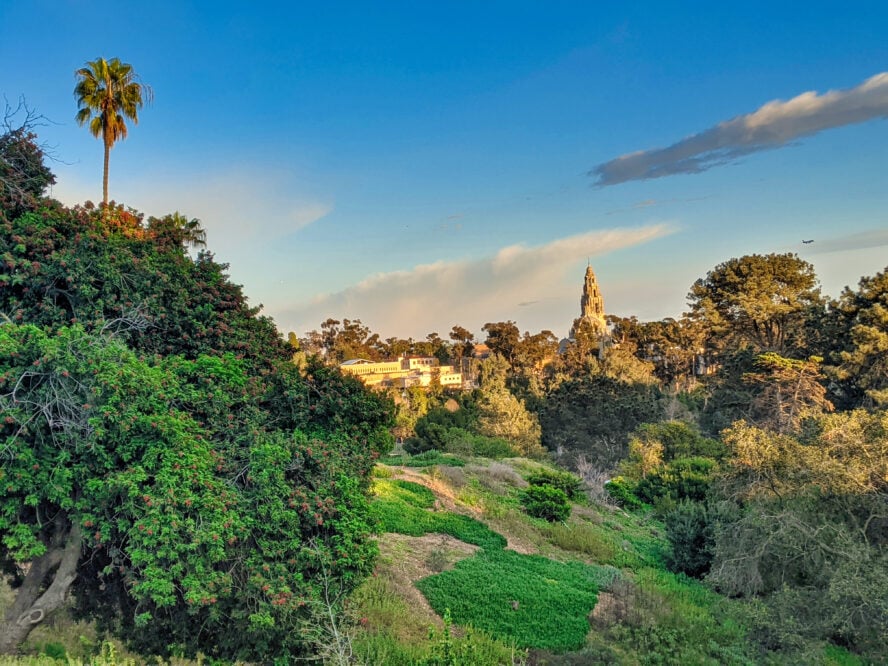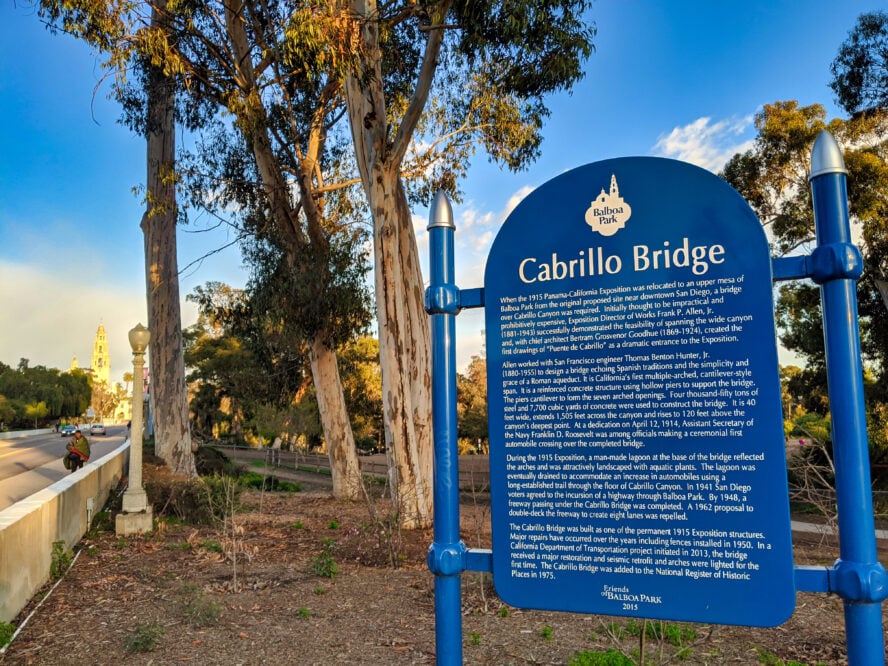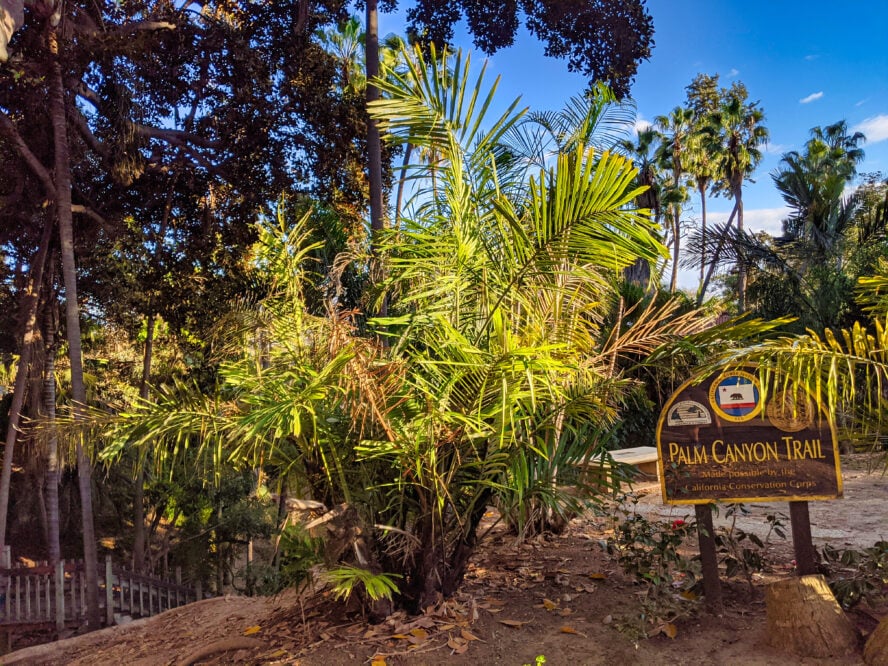Considered one of the premier destinations in San Diego, Balboa Park is one of the most visited places in the city. Given its expansiveness, it’s a great urban hiking destination. The trail through the park visits fountains, world-class architecture, botanic gardens, and more—some of which are free to enter and all of which are among the most photographed places in the city.
The Central Park of San Diego, 65 miles of trail connects 17 museums, the famous San Diego Zoo, and numerous gardens and fountains. While many folks drive up and choose one destination, this five-mile urban hike takes you past the architectural, botanical, historical, and cultural landmarks of the city. While Balboa Park is known for its human-made attractions, its natural areas and hiking trails add to the uniqueness of what Balboa Park has to offer.

The Five Gateways to Balboa Park
Balboa Park has five hiking trailhead gateways: Morley Field, Park Blvd., Sixth and Upas, Golden Hill, and Marston Point. Each gateway has a kiosk with a large map of the hiking trails in the area. Most trails are marked with colored and numbered markers. While these markers aren’t at every intersection, major trails are visible on Google Maps, and you’ll always have cell reception in the park, so navigating back to your car shouldn’t be an issue.
Each trail is also rated by difficulty, taking into account elevation gain and the terrain it covers. Most numbered hiking trails are on a combination of dirt, sidewalks, and paved paths, so plan to bring shoes with good traction and enough cushioning for soft and harder surfaces. If there’s been rain, some dirt trails can be muddy for a few days after, so you may opt for a hiking route that utilizes more paved surfaces and sidewalks.
Balboa Park Has Great Hikes for Families or People Strapped for Time
With 65 miles of trails and numerous attractions, locals and visitors alike have their own opinions on which is the best of the numbered trails to hike. Still, for those visiting San Diego for the first time (and otherwise weren’t planning to visit Balboa Park separately), I advise a combination of Route #43 and #44.
This nearly five-mile loop touches on highlights that make the park one of the finest in the U.S., including the 1915 1915 Panama-California Exposition grounds, views from the West Mesa, the architectural beauty of the Cabrillo bridge, and gardens that showcase native trees and botany of San Diego.

Before you go, check the weather and predicted temperature for the day. Although there are trees and shade in some parts of the park, during summer, it’s better to get your hiking done during the morning and save the afternoons for air-conditioned museums.
While the park is well-trafficked by tourists and locals alike during the day, the park closes at dusk. San Diego, like most West Coast cities, has a population of houseless people who camp in parks at night.
This urban adventure takes hikers longer than they expect because it’s designed for exploration. I recommend taking the time to visit the free botanic garden or art museums, play in fountains, listen to live music, and take lots of photos.
Forested Views and Native Plants in Balboa Park
Start at the Cypress Grove Picnic area, heading south on the paved trail towards Cabrillo Bridge. You’ll pass gnarled trees, a medicinal plants garden, and forested picnic areas—most with informational placards. Admire Cypress Point and Redwood Circle, which both have expansive views east over the forested Cabrillo canyon towards the California Tower. Its ornate dome is one of the most recognizable landmarks in San Diego.
Walk behind the Bowling Green, where enthusiastic players can be seen almost every afternoon. Then, you’ll find yourself on Cabrillo Bridge, a pedestrian and car bridge that connects Uptown to El Prado Complex, the former grounds of the 1915 Panama-California Exposition.
The Walk Across Cabrillo Bridge
The 450-foot long Cabrillo Bridge spans 150 feet above the forested Cabrillo Canyon. Built for the 1915 Panama Exposition, the bridge is designed after the Alcantara Bridge in Toledo, Spain. It was the first multiple arched cantilever bridge in California. When it was dedicated in 1914, Franklin D. Roosevelt gave the opening speech and was a passenger in the first car crossing.
Nowadays, cars are still allowed on the bridge, but it’s mainly used by pedestrians. Crossing the bridge is a fun experience for pedestrians. It’s incredible to look down at the floor of the valley while suspended so high above, and the panorama rivals the best Grand Canyon hikes. The Cabrillo Bridge was nominated for the National Historic Register of Places in the 1970s.

El Prado (1915 Panama Exposition Grounds)
Whether you are a hiker or not, I think the El Prado is the #1 must-see attraction in San Diego. A historic district, the pedestrian-friendly complex was designed by famed architects Bertram Goodhue and Carleton Winslow. The next mile or so of your hike visits an area also on the National Register of Historic Places.
From the California Quadrangle and California Tower, explore the El Prado Arcade, an arched covered walkway. In summer, I’ve walked through it instead of in the plaza for shade. Pass numerous fountains, including the reflecting pool in front of the Botanical Building. One of the largest lath structures in the world, the garden building, and pool in front are considered the most photographed spot in San Diego. I’m fond of watching the koi and red-eared slider turtles swim in the pond nearby.
A pedestrian pathway takes you to Spanish Village, a complex of art galleries. Elephant topiaries announce you’re approaching the entrance of the San Diego Zoo. While this is another must-see in San Diego, you’ll want to dedicate a full day to the experience, so I wouldn’t advise taking the zoo detour while on this hike.
Head towards the Historic Carousel and Miniature Train until you pass the giant Moreton Bay Fig Tree. It’s the largest Ficus macrophylla in the park with a trunk girth of 486 inches and numerous aerial roots. I’m a big fan of the giant fig trees throughout the park, but this one takes the cake on size alone.
Don’t miss Palm Canyon
After visiting the fountain by the Natural History Museum, return through the plaza before taking a detour to the left. You’ll pass above the Japanese Garden on your way to the Spreckels Organ Pavilion, the world’s largest pipe organ in a fully outdoor venue.
Descend the dirt trail to Palm Canyon, the most natural and serene part of this hike. This shaded forested area is a palm oasis similar to what you’d find in the eastern part of the county. Like an oasis in a wild area, it is home to many birds. Climb wooden stairs up to Alcazar Garden before recrossing the Cabrillo Bridge.

Here, if I still have the energy and daylight, I like to turn left after Nate’s Point dog park to visit the West Mesa. After crossing Pine Grove Picnic Area, you’ll reach Marston Point. I like this part of Balboa Park because it is forested and feels more peaceful and quiet than other parts of the park. It’s a nice reprieve from the busy museum district. There are expansive views south towards downtown.
From here, follow the lightly trafficked road back to your car.


